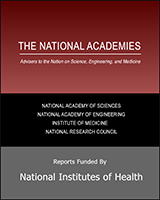NCBI Bookshelf. A service of the National Library of Medicine, National Institutes of Health.
Excerpt
Most food-borne illnesses are preventable. The interconnectedness of individual, regional, and global public health; the health of the planetary environment(s); and billions of food animals and wildlife would suggest the need for a new paradigm—one that shifts away from a reactive to a more anticipatory, proactive approach to food safety. Such a prime example might be captured in a “One Health” approach to food safety—which has been defined as “the collaborative effort of multiple disciplines—working locally, nationally, and globally—to attain optimal health for people, animals and the environment” (AVMA, 2008). Were such an approach to be implemented for food safety, it may hold the promise of harnessing and integrating the expertise and resources from across the spectrum of multiple health domains including the human and veterinary medical, and plant pathology, communities with those of the wildlife and aquatic health and ecology communities.
Contents
- THE NATIONAL ACADEMIES
- FORUM ON MICROBIAL THREATS
- BOARD ON GLOBAL HEALTH
- PLANNING COMMITTEE ON GLOBAL INFECTIOUS DISEASES AND FOOD SAFETY
- Reviewers
- Acknowledgments
- Workshop Overview
- Appendix A: Contributed Manuscripts
- A1 EHEC O104:H4 IN GERMANY 2011: LARGE OUTBREAK OF BLOODY DIARRHEA AND HAEMOLYTIC URAEMIC SYNDROME BY SHIGA TOXIN–PRODUCING E. COLI VIA CONTAMINATED FOOD
- A2 ONE HEALTH AND HOTSPOTS OF FOOD-BORNE EIDS
- A3 PLANT FOOD SAFETY ISSUES: LINKING PRODUCTION AGRICULTURE WITH ONE HEALTH
- A4 ONE HEALTH AND FOOD SAFETY—THE CANADIAN EXPERIENCE: A HOLISTIC APPROACH TOWARD ENTERIC BACTERIAL PATHOGENS AND ANTIMICROBIAL RESISTANCE SURVEILLANCE
- A5 OVERVIEW OF THE GLOBAL FOOD SYSTEM: CHANGES OVER TIME/SPACE AND LESSONS FOR FUTURE FOOD SAFETY
- A6 THE AUSTRALIAN PERSPECTIVE, THE BIOSECURITY CONTINUUM FROM PREBORDER, TO BORDER AND POSTBORDER
- A7 FOOD SAFETY: A VIEW FROM THE WILD SIDE
- A8 ONE HEALTH AND FOOD SAFETY
- A9 FOOD-BORNE VIRUSES FROM A GLOBAL PERSPECTIVE
- A10 MICROBE HUNTING AND PATHOGEN DISCOVERY
- A11 TRANSMISSION OF HUMAN INFECTION WITH NIPAH VIRUS
- A12 DATE PALM SAP LINKED TO NIPAH VIRUS OUTBREAK IN BANGLADESH, 2008
- A13 FOOD-BORNE PATHOGEN CONTROL PROGRAMS
- A14 EMERGING FOODBORNE PATHOGENS AND PROBLEMS: EXPANDING PREVENTION EFFORTS BEFORE SLAUGHTER OR HARVEST
- A15 ANTIBIOTIC RESISTANCE—LINKING HUMAN AND ANIMAL HEALTH
- A16 ORIGINS OF MAJOR HUMAN INFECTIOUS DISEASES
- A17 THE OUTLOOK FOR PUBLIC FOOD SAFETY RESEARCH AND USDA SCIENCE
- Appendix B Agenda
- Appendix C Acronyms
- Appendix D Glossary
- Appendix E Speaker Biographies
Rapporteurs: Eileen R. Choffnes, David A. Relman, LeighAnne Olsen, Rebekah Hutton, Alison Mack
Financial support for this project was provided by the American Society for Microbiology; Burroughs Wellcome Fund; GlaxoSmithKline; Infectious Diseases Society of America; Merck Company Foundation; sanofi pasteur; U.S. Agency for International Development; U.S. Department of Defense, Department of the Army: Defense Threat Reduction Agency, Global Emerging Infections Surveillance and Response System, and the Medical Research and Materiel Command; U.S. Department of Health and Human Services: Centers for Disease Control and Prevention, Fogarty International Center, Food and Drug Administration, National Institute of Allergy and Infectious Diseases, and National Institutes of Health; U.S. Department of Homeland Security; and U.S. Department of Veterans Affairs.
Suggested citation:
IOM (Institute of Medicine). 2012. Improving food safety through a One Health approach. Washington, DC: The National Academies Press.
The views presented in this publication do not necessarily reflect the views of the organizations or agencies that provided support for this project.
NOTICE: The project that is the subject of this report was approved by the Governing Board of the National Research Council, whose members are drawn from the councils of the National Academy of Sciences, the National Academy of Engineering, and the Institute of Medicine.
- NLM CatalogRelated NLM Catalog Entries
- Perspective: One Health: a compelling convergence.[Acad Med. 2013]Perspective: One Health: a compelling convergence.Shomaker TS, Green EM, Yandow SM. Acad Med. 2013 Jan; 88(1):49-55.
- One Health: An opportunity for an interprofessional approach to healthcare.[J Interprof Care. 2015]One Health: An opportunity for an interprofessional approach to healthcare.Courtenay M, Sweeney J, Zielinska P, Brown Blake S, La Ragione R. J Interprof Care. 2015; 29(6):641-2.
- Implementing One Health as an integrated approach to health in Rwanda.[BMJ Glob Health. 2017]Implementing One Health as an integrated approach to health in Rwanda.Nyatanyi T, Wilkes M, McDermott H, Nzietchueng S, Gafarasi I, Mudakikwa A, Kinani JF, Rukelibuga J, Omolo J, Mupfasoni D, et al. BMJ Glob Health. 2017; 2(1):e000121. Epub 2017 Feb 21.
- Review [Human ecology and interdisciplinary cooperation for primary prevention of environmental risk factors for public health].[Przegl Lek. 2007]Review [Human ecology and interdisciplinary cooperation for primary prevention of environmental risk factors for public health].Dobrowolski JW. Przegl Lek. 2007; 64 Suppl 4:35-41.
- Review Improving food safety in the domestic environment: the need for a transdisciplinary approach.[Risk Anal. 2005]Review Improving food safety in the domestic environment: the need for a transdisciplinary approach.Fischer AR, de Jong AE, de Jonge R, Frewer LJ, Nauta MJ. Risk Anal. 2005 Jun; 25(3):503-17.
- Improving Food Safety Through a One Health ApproachImproving Food Safety Through a One Health Approach
Your browsing activity is empty.
Activity recording is turned off.
See more...
